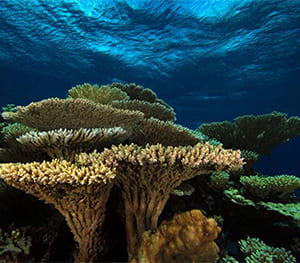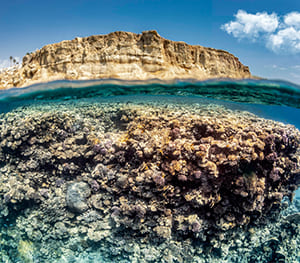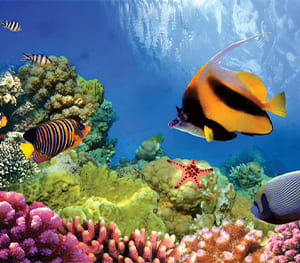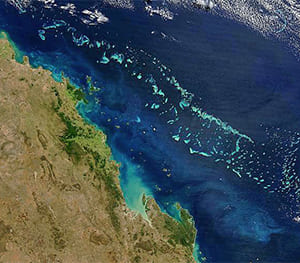Ever wondered about coral reefs? If so then you might be stunned to read that they are not even plants but animals! Interesting, right? Then, brace yourself for some surprising facts about the coral reef.
These complex skeletons, which are made of tiny coral polyps, are home to an endless variety of flora and animals. Beyond being undersea natural wonders, coral reefs are vital to fisheries and may hold the key to developing novel cancer treatments.
Come explore the amazing facts about the coral reef that add to the planet’s most varied ecosystem!
Disclosure: This article contains affiliate links. When you follow a link to purchase the products, I sometime earn a commission, at no additional cost to you. Read my full disclosure here
What is a Coral Reef?
Corals the animal, is basically related to the family of jellyfish and anemones. They have a central mouth and use tentacles that resemble arms to catch plankton. They turn corals into coral reefs by secreting strong calcareous exoskeletons, which create expansive reefs that resemble finger-shaped or branching formations. These colonies, which are primarily made of hard corals, frequently harbor symbiotic algae that work together for mutual benefit through photosynthesis.
Although, Corals are resilient enough they still face threats like diseases like black band and white band and coral bleaching when under stress. Hawaii recorded the first black band disease case in 1994, highlighting the vulnerability of these essential undersea ecosystems.

Types of Coral Reef
Around the world, coral reefs take on a variety of forms, differing in location and structure. There are three notable kinds:
1. Fringing Reef (Shore Reef)
As coastal corals erode, these reefs form fringing lagoons as they progressively stretch out from the coast. Corals in the Red Sea are a prime example.

2. Barrier Reef
Famous examples such as the Great Barrier Reef are found close to the edge of continental plates, resulting in heavily inhabited regions with a precipitous drop to the seafloor and large lagoons.

3. Platform Reef
These reefs, which grow on continental shelves far from the coast, are shallow-water ecosystems that are wider at the top and closer to the seabed. They take on various shapes due to erosion, which helps create atolls in the open ocean.

Life in Wonderland: Inhabitants of Coral Reef
Numerous marine animals, including giant clams, starfish, sea turtles, seahorses, eels, and cuttlefish, live in vibrant communities within coral reefs. These rich ecosystems provide all the necessities for these varied animals, including food and shelter.
Many inhabitants of reefs use clever camouflage among the coral to either elude predators or approach prey undetected. Furthermore, plants—such as the sea grass and algae in soft coral—play vital roles in the growth of the coral reef by serving as food for animals like turtles and dugongs.
10 Interesting Facts about Coral Reef
1. They are Animals, not Plants
First and foremost, out of all the facts about the coral reef is their identity. Because of their attachment to the seabed, many people mistakenly think of corals as plants. As with jellyfish, corals are actually animal cnidarians. The core is formed by the central polyp, a living organism encased in a tough exoskeleton. Corals multiply as they grow over millions of years to increase the area covered by reefs.
2. Slowest Growing Organism
The slowest-growing organisms on Earth are corals, which have skeletons made of calcium carbonate. For a few square kilometers, growth of only one centimeter per year is typical, taking approximately one million years. Growth is influenced by variables such as nutrition and water quality; certain plants that thrive in ideal conditions can grow more than 10 centimeters a year.
3. The Natural Water Purifier
Corals use tiny sieves to function as natural filters because they are sensitive to changes in their surroundings. They efficiently remove particulate matter from seawater while adjusting to changes in salinity and temperature.
4. Stability of the Seabed
Coral reefs play a critical role in stabilizing the sea bed amidst growing sand mining and human-induced erosion by preventing large-scale land shifts through their growth. This is one of the most beneficial facts about the coral reef.
5. Coral Resilience in the Red Sea
The coral reef in the Red Sea exhibits remarkable resilience against the effects of Thalassomonas Loyola, as well as remarkable resistance to temperature changes and bacterial bleaching.
6. Depth Restriction
Corals require ideal conditions to flourish in certain oceanic regions. Water depth is important because they grow best in clear, deep waters with lots of oxygen. Coral growth is restricted below a certain depth due to the photosynthesis of zooxanthellae, which are symbiotic algae within the coral.
7. Colorful Reefs
Another interesting fact about the coral reef is how they get their color, Algae’s Vibrant Touch Microscopic algae known as zooxanthellae are responsible for the corals’ stunning color. Both parties benefit from this symbiotic relationship, as algae change color in response to environmental factors and species. The color of the reefs is more vibrant near the surface because the algae there are better at using sunlight for photosynthesis.
8. Protectors Against Hurricanes
In addition to being important tourist attractions, facts about the coral reef include that coral reefs protect coastal areas by substantially lowering the energy of hurricanes and storms by nearly 97%.
9. Potential Uses in Medicine
Scientists have verified the therapeutic qualities of corals, despite historical assertions, emphasizing the priceless ecosystem services that may have therapeutic uses.
10. Thrives in Strong Currents
Surprisingly, corals thrive in places with strong currents. According to studies related to facts about the coral reef, strong currents maintain cool, steady surface temperatures, which is essential for coral survival. Furthermore, corals in these areas survive by feeding on plankton and zooplankton that have become trapped in the reef, despite the nutrient-poor water.
How Can We Help Coral Reefs Thrive?
- Take Care When Diving: Select a dive or snorkel operator who is dedicated to environmental practices when organizing your underwater experience. Seek out those connected to Green Fins, an international program that guarantees ethical and sustainable methods for preserving marine life and coral reefs.
- Think Before You Pack: To avoid damaging coral reefs, think about using shampoos and sunscreens that are safe for the environment before your trip. Bring your own reusable water bottle and cutlery to help reduce the use of single-use plastic.
- Pay Attention to Your Step: Recall that coral reefs are fragile environments. Steer clear of walking on them or touching them as this can damage or even kill the coral.
- Avoid Water Pollution: Get rid of your waste properly to help fight ocean pollution. Take your trash home if your dive operator doesn’t have a bin so it doesn’t harm coral reefs or marine life.
- Maintain the Sand Settled: When swimming, exercise caution to avoid stirring up sediment. This kind of disruption can suffocate corals, making it more difficult for them to photosynthesize and encouraging the spread of illnesses.
- Encourage conservation: Donate to Reef-World to support the preservation of coral reefs. With your help, instructional programs could be funded, encouraging dive and snorkel operators to use environmentally friendly methods.
- Allow fish to naturally eat: Avoid giving in to the urge to feed fish when you are underwater. Fish are more susceptible to predators when they are fed, which upsets the natural equilibrium and has an effect on the ecosystem.
- Say No to Souvenirs: Steer clear of souvenirs featuring coral and marine life since they are frequently removed from their natural habitat, harming the ecosystem. Choose eco-friendly presents that encourage travel to your area.
Conclusion
Coral reefs are fascinating, and it’s important to protect them. Even though you may have witnessed these underwater marvels, most people confuse corals for plants! These are, surprisingly, animals that graze on the micronutrients and have some amazing benefits to the ecosystem. Knowing these things makes it easier for us to value and protect these special ecosystems.



